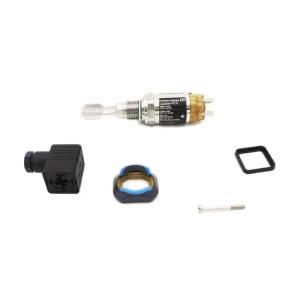What is the Liquiphant FTL31
- The Liquiphant FTL31 is a point level switch designed for detecting liquid level (or the presence/absence of liquid) at a specific point (as opposed to continuous level measurement).
- It uses the vibronic / tuning fork principle: a fork vibrates at a given resonance frequency; when the fork is immersed in a liquid, that resonance frequency shifts, which is detected by the electronics.
Key Technical Specifications
Here are some of its main specs & capabilities:
|
Spec
|
Value / Range
|
|
Process temperature
|
−40 °C to +150 °C
|
|
Process pressure
|
Vacuum up to +40 bar (≈ 580 psi)
|
|
Minimum density of medium
|
Standard >0.7 g/cm³; optionally >0.5 g/cm³
|
|
Wetted materials
|
Stainless steel 316L (for all parts in contact with process liquid)
|
|
Process connections
|
Various threaded connections: G½, G¾, G1, NPT etc.
|
|
Electrical / Output options
|
3-wire DC-PNP (10-30 V DC), or 2-wire AC/DC (20-253 V)
|
|
Communication / Features
|
Some versions have IO-Link; continuous self-monitoring; LED indicators; plug-and-play, no calibration needed.
|
Applications / Use Cases
- Overfill protection: to detect when liquid reaches a certain high level to prevent spillovers.
- Dry-run protection: detecting when a pump’s liquid level drops too low.
- Lower level detection: as a safety / control switch in tanks, vessels, pipes.
- Industrial machinery, cleaning systems, anywhere a simple reliable point-level detection is needed.
Key Advantages
- Reliability & Safety: It has built-in continuous self-monitoring, meaning if power is lost or there's a fault, the sensor gives a safe (fail) signal.
- Insensitive to many disturbances: Turbulence, flows, air bubbles, conductivity, foam-build-up or changing media properties have little to no effect. The resonance-based tuning fork is fairly robust in these conditions.
- No calibration needed: Reduces setup time and maintenance.
- Compact and rugged design: Stainless steel housing; various mounting and connection options; high pressure/temperature capability.
- Multiple output / electrical versions: Good flexibility to match with different control systems (DC, AC, PNP, etc.).
Things to Consider / Limitations
- Minimum density requirement: Standard versions require medium density >0.7 g/cm³. If your liquid is lighter, you’ll need the optional version (>0.5 g/cm³).
- Not suitable for all hazardous-area use: The FTL31 is not suited for some hazardous area classifications; for hygienic or especially demanding environments, other models (e.g. FTL33) might be more appropriate.
- Switching point location depends on installation: Orientation, mounting, distance from walls, etc., can affect the exact switch point. Proper installation is important (vertical, horizontal, ensuring fork drains off etc.).
- Response time / hysteresis: There is some delay when the fork is covered vs uncovered, and hysteresis (difference between on/off switching) to be considered in tight control loops.
